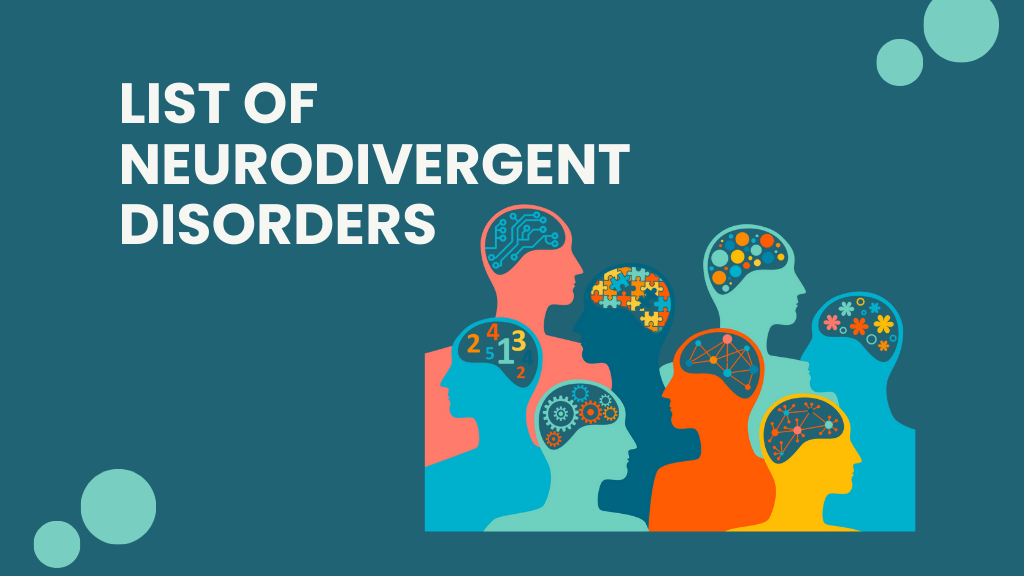Neurodiversity is a concept that recognizes the wide range of differences in human brain function and behavior. Instead of viewing certain conditions as deficits, neurodiversity highlights them as natural variations of the human mind. Understanding the list of neurodivergent disorders is essential for building a more inclusive society where people are valued for their unique perspectives and strengths. These conditions may impact learning, communication, attention, and social interaction, but they also contribute to creativity, problem-solving, and innovation. This article explores the major types of neurodivergent disorders, providing clear explanations to help readers gain better awareness and appreciation for diversity in cognition.
What Does It Mean to Be Neurodivergent?
The term “neurodivergent” generally refers to individuals whose brain functions differ from what society considers typical. This includes differences in attention, learning, social skills, sensory processing, and emotional regulation. Neurodivergence does not imply inferiority; rather, it reflects diversity in human minds. By looking at these conditions, we can see how each one brings challenges but also unique strengths that can benefit communities when properly supported.
List of Neurodivergent Disorders
Below is a detailed explanation of the most recognized neurodivergent disorders. Each condition has distinct traits, but together they reflect the wide spectrum of cognitive diversity
Autism Spectrum Disorder (ASD)
Autism Spectrum Disorder is one of the most well-known neurodivergent conditions. It affects communication, social interaction, and behavior. People with ASD may struggle with understanding social cues, maintaining eye contact, or adjusting to changes in routine. However, many also demonstrate exceptional focus, attention to detail, and strong memory skills. Autism exists on a spectrum, meaning symptoms vary from person to person, ranging from mild challenges to more significant support needs. Early intervention, therapies, and inclusive education can make a big difference in the lives of individuals with autism.
Attention-Deficit/Hyperactivity Disorder (ADHD)
ADHD is characterized by difficulties with attention, impulse control, and hyperactivity. People with ADHD may find it challenging to focus on tasks, manage time, or stay organized. On the other hand, they often display creativity, adaptability, and high energy that can be channeled into productive work. ADHD is not limited to childhood; many adults also live with the condition, learning strategies to manage their attention and harness their strengths. Today, workplaces are becoming more accommodating, allowing individuals with ADHD to succeed in flexible and dynamic roles
Dyslexia
Dyslexia is a learning difference that primarily affects reading, writing, and spelling. Individuals with dyslexia may struggle with letter recognition, word decoding, or fluency in reading. Despite these challenges, many develop strong problem-solving abilities, storytelling skills, and creative thinking. With proper support, dyslexic individuals can excel in academic and professional settings. Advances in technology, such as text-to-speech tools, audiobooks, and specialized apps, have made learning more accessible for those with dyslexia.
Dyscalculia
Dyscalculia is often referred to as “math dyslexia” because it affects a person’s ability to understand numbers, arithmetic, and mathematical concepts. Those with dyscalculia may find it difficult to grasp number relationships, perform calculations, or understand time and measurement. While math can be a challenge, many individuals with dyscalculia thrive in areas such as language, art, and social interaction. With tailored teaching methods, they can build confidence and learn strategies to manage daily tasks that involve numbers.
Dysgraphia
Dysgraphia impacts handwriting, spelling, and the ability to organize written work. Children and adults with dysgraphia may struggle with forming letters, spacing words, or structuring sentences. However, many develop strong verbal communication and creative storytelling skills that compensate for difficulties with writing. Supportive strategies, such as assistive technology, speech-to-text tools, and individualized instruction, can help individuals express themselves effectively without being limited by handwriting challenges.
Dyspraxia (Developmental Coordination Disorder)
Dyspraxia is a motor coordination disorder that affects movement and planning. Individuals may have trouble with balance, fine motor tasks, or physical coordination. Everyday activities such as tying shoelaces or handwriting can be difficult. Yet, dyspraxic individuals often excel in problem-solving, determination, and creative pursuits, making meaningful contributions in various fields. Physical and occupational therapy can greatly improve motor skills and help individuals build independence.
Tourette Syndrome
Tourette Syndrome is a neurological condition characterized by involuntary movements and vocalizations known as tics. These can range from mild to severe and may include blinking, facial grimacing, or sudden sounds. While Tourette’s can be socially challenging, many people with the condition are intelligent, resilient, and capable of leading successful lives. Public awareness and acceptance play a key role in supporting individuals with Tourette Syndrome. With treatment and support, many people learn to manage their tics and reduce their impact on daily life.
Obsessive-Compulsive Disorder (OCD)
OCD is marked by intrusive thoughts (obsessions) and repetitive behaviors (compulsions) performed to ease anxiety. For example, a person may repeatedly wash their hands or check locks. Although OCD can interfere with daily life, individuals with this condition often develop strong analytical skills, persistence, and attention to detail. With therapy and support, many learn to manage their symptoms effectively. Modern treatment options, including cognitive behavioral therapy and medication, have proven highly effective for people living with OCD.
Sensory Processing Disorder (SPD)
SPD occurs when the brain has difficulty processing sensory information such as sound, light, touch, or taste. Some individuals may be overly sensitive, while others may seek intense sensory input. This condition often co-occurs with autism but can exist independently. People with SPD may struggle in environments with loud noise or bright lights, but they often have heightened awareness and unique sensory experiences that shape their perspective of the world. Sensory-friendly environments and therapy help individuals cope and thrive.
Social Anxiety Disorder
Social anxiety disorder is characterized by intense fear or discomfort in social situations. While it is primarily considered a mental health condition, it is often discussed in the context of neurodivergence due to its impact on social processing and communication. Individuals may avoid gatherings, struggle with public speaking, or overanalyze interactions. However, many develop empathy, thoughtfulness, and strong listening skills. With support, such as therapy or gradual exposure techniques, individuals can learn to manage anxiety and build confidence.
Bipolar Disorder
Bipolar disorder is a mood condition that involves cycles of depression and mania. During depressive episodes, individuals may feel low energy, sadness, or hopelessness, while manic phases bring increased energy, impulsivity, and creativity. Though it presents challenges, many people with bipolar disorder channel their intense emotions into art, writing, and innovation. With proper medical support, lifestyle changes, and community understanding, individuals with bipolar disorder can live balanced and fulfilling lives.
Schizophrenia
Schizophrenia is a complex condition that affects perception, thinking, and behavior. Individuals may experience hallucinations, delusions, or disorganized thinking. Despite the stigma, many people with schizophrenia can lead fulfilling lives with proper treatment and support. They often bring unique insights and perspectives to creative and intellectual work. Greater awareness and compassion are needed to break stereotypes and ensure that individuals with schizophrenia are valued as active members of society.
Living with Neurodivergence
Living with a neurodivergent condition can bring both challenges and strengths. While some individuals may require additional support in education, work, or daily life, others thrive in their chosen fields by harnessing their unique talents. The growing acceptance of neurodiversity is helping to shift attitudes, encouraging schools and workplaces to adapt rather than expect everyone to fit a single mold. Emphasizing strengths, offering flexible support systems, and reducing stigma allow neurodivergent individuals to flourish and contribute meaningfully to society. Recognizing these differences is only the beginning—what matters most is ensuring acceptance and empowerment for those who live with them every day.
FAQs
What does “neurodivergent” mean?
It refers to individuals whose brain functions differ from the typical patterns, affecting learning, attention, emotions, or social interactions.
Are all neurodivergent disorders lifelong?
Many conditions such as autism and ADHD are lifelong, but with support, individuals can learn coping strategies and thrive.
Can someone have more than one neurodivergent disorder?
Yes, it is common for individuals to experience overlapping conditions, such as ADHD and dyslexia or autism and anxiety.
How can workplaces support neurodivergent employees?
Employers can provide accommodations like flexible schedules, assistive technology, and clear communication while fostering an inclusive culture.
Is neurodivergence the same as mental illness?
Not exactly. Some neurodivergent disorders are developmental or learning differences, while others overlap with mental health conditions. Both require understanding and support.
Conclusion
The list of neurodivergent disorders illustrates the many ways in which human brains work differently. From autism and ADHD to dyslexia, OCD, and schizophrenia, these conditions show that diversity of thought and behavior is part of human identity. By recognizing strengths as well as challenges, society can create opportunities where neurodivergent individuals thrive.
It is important to remember that neurodivergence is not a limitation, but rather a reflection of the incredible variety of human cognition. Each disorder carries unique traits that can present obstacles, yet these same traits often come with powerful abilities such as creativity, deep focus, empathy, and problem-solving. When educational systems, workplaces, and communities focus on empowerment instead of stigma, they unlock the true potential of neurodivergent individuals.





